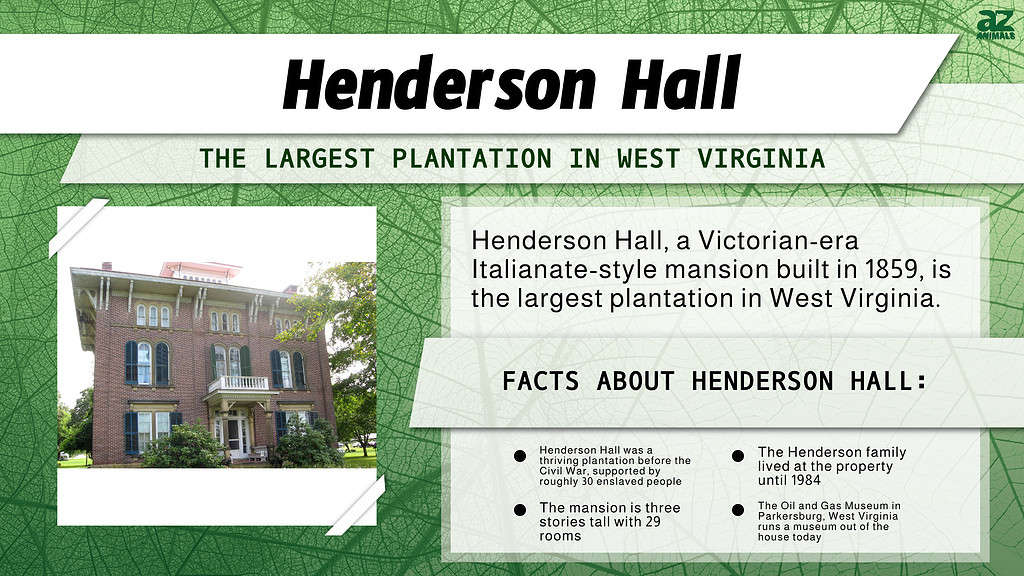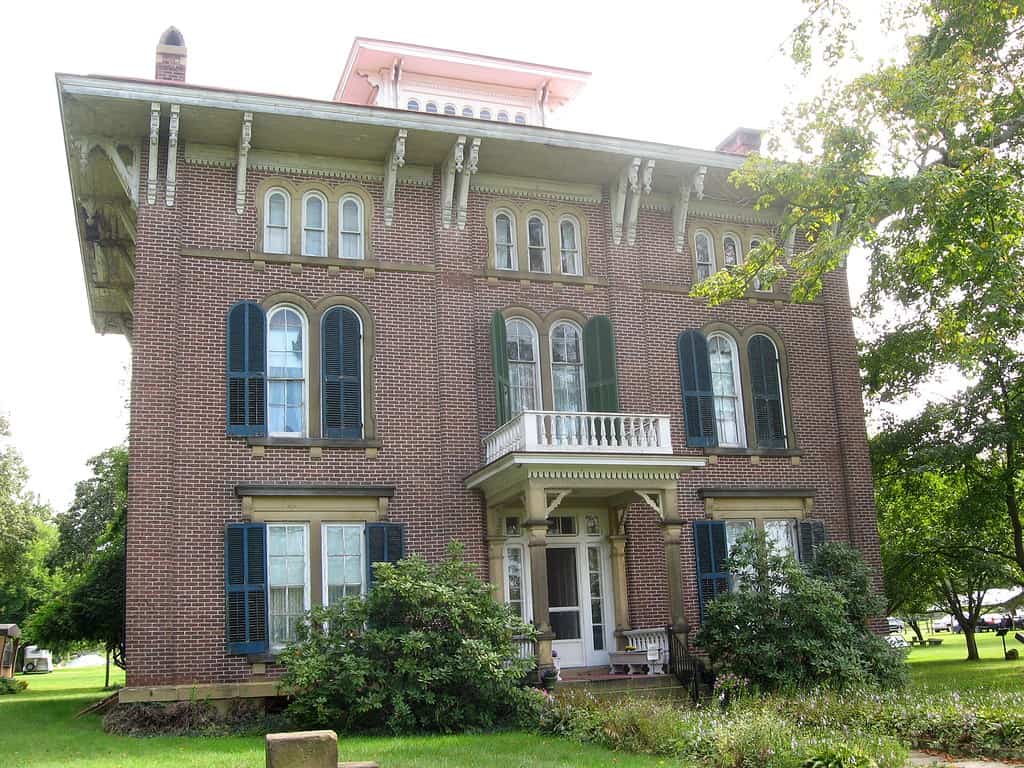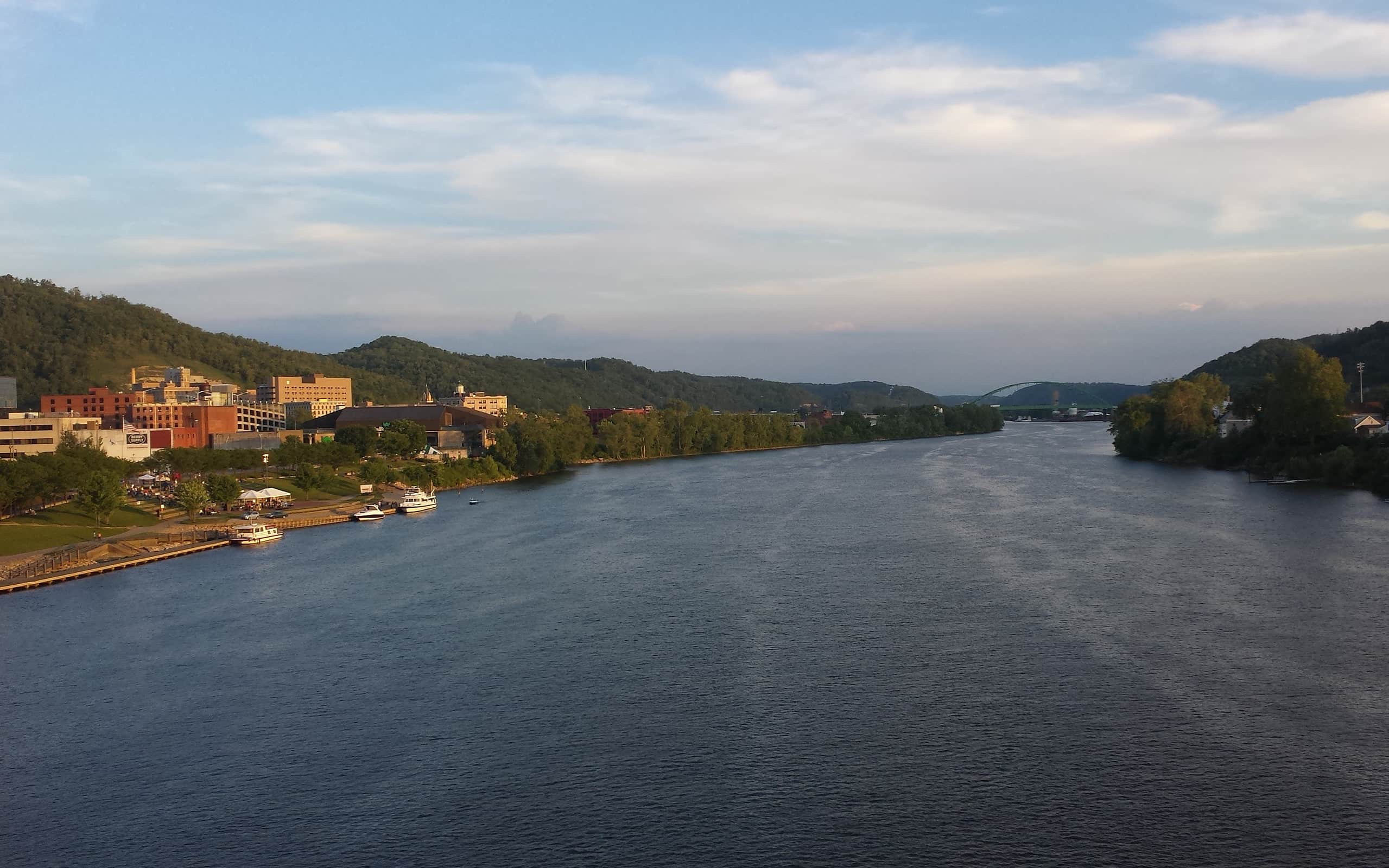Nestled along the banks of the Ohio River sits Henderson Hall. Located in Williamstown, West Virginia, the G.W. Henderson Plantation is one of the few remaining plantations left in the state. Henderson Hall was constructed in 1836 from a spot that overlooks the Ohio River. This three-story, 29-room Victorian-era Italianate-style mansion was completed in 1859. The house was constructed by using brick, stone, and timber from the Henderson Property. Let’s dive in and discover the largest plantation in West Virginia that pays tribute to the heart of the Appalachians.

The Henderson Family
The Scottish-born Alexander Henderson, Sr. arrived in Virginia in the 1700s. He was later appointed to serve on a committee to help decide the boundary lines between Maryland and Virginia. Henderson was friends with Thomas Jefferson, James Madison, and George Washington. It was the latter who encouraged Henderson to purchase 25,000 acres of land in what was then western Virginia. Henderson sent three of his sons out to view the land, which was pure wilderness in the Mid-Ohio Valley.
The Henderson brothers, Alexander and John, thwarted the treason of Aaron Burr. Harmon Blennerhassett and Aaron Burr attempted to recruit the Henderson brothers to participate in Burr’s scheming, but the Henderson brothers reported the ploy to President Jefferson and Secretary of State Madison. Blennerhassett owned a mansion on an island in the middle of the Ohio River near present-day Parkersburg, West Virginia. After Harmon and his wife, Margaret, got caught up in Burr’s schemes, the couple lost their mansion and money. As a result, the couple never regained their wealth. However, the Henderson brothers were a crucial part of ensuring Burr would never gain political power after killing Alexander Hamilton.

Henderson Hall sits along the banks of the Ohio River near Williamstown, West Virginia.
©ReDunnLev/iStock via Getty Images
The G.W. Henderson of Henderson Hall
George Washington Henderson, the grandson of Scottish immigrants, married Elizabeth Ann Tomlinson in 1826. At the time of their marriage, the couple owned 2,000 acres in Wood County, West Virginia. G.W. studied law at Marietta College and served at the 1861 Wheeling Convention. G.W. was loyal to the Union during the Civil War, even though his family in Virginia joined the Confederacy. It was G.W. who later built Henderson Hall.
Architectural Features
The mansion itself is three stories tall with 29 rooms. The main hall alone is 8,000 square feet. The Italianate style is evident in the round-topped windows and the front porch with hand-carved stone columns, just to name a few features. Located at the rear of the house is the two-story brick kitchen.
The property sits on over 2,000 acres, the land is home to a carriage barn, schoolroom, corn crib, scale house (used for farming equipment), cow barn, barn, and tenant house. The property also includes the Henderson Cemetery, a Stone Wall Terrace, and three prehistoric Indian Mounds. The mounds on the property are associated with the Adenas tribe. Even more, the Baltimore and Ohio Railroad passes right through the historic part of the farmland, near the Ohio River. The railroad is not related to the plantation’s historical significance.
This plantation is the largest, best-preserved 19th-century plantation surviving on the West Virginia side of the Ohio Valley.
Henderson Hall History

The front entrance of Henderson Hall exhibits hand-carved columns.
©Chrispainter1966, CC BY-SA 3.0 , via Wikimedia Commons – Original / License
Henderson Hall was a thriving plantation before the Civil War. Nearly 30 enslaved people worked on the plantation. The farm remained a significant fixture in the community until about 1935. The Henderson family lived at the property until 1984. At that point, a cousin of the family became the owner. Before he passed away, he willed the property to the Oil and Gas Museum in Parkersburg, West Virginia, who currently staff the house and maintain it as a museum.
The house, its grounds, and the Henderson Family Cemetery are listed on the National Registry of Historic Places. Likewise, Henderson Hall is now a museum open for tours.
According to a docent at the museum, everything in the house is original to the Hendersons. The family never parted with anything, which means that the museum is a true testament to the family’s past and the state’s history. Museum officials have sorted through thousands of items. These items range from 200 years of schoolbooks, diaries, and shopping lists. In one room there might be China from the 1700s, while another room has a 100-year-old bottle of whiskey, never opened. The carriage house still holds the buggy that carried Henderson and his wife to Niagara Falls for their honeymoon.
Visiting the Largest Plantation in West Virginia
Henderson Hall is open for tours Wednesday through Sunday, 12 p.m. to 5 p.m. The museum tours are self-guided. You can find Henderson Hall in Williamstown, West Virginia, situated between Parkersburg and Williamstown, right along the Ohio River. The Ohio River was one of the main draws for Henderson to build, and to this day, the views of the riverfront make it clear why this was the desired spot for the plantation. To this day, Henderson Hall resonates as an important representation of Appalachian history and culture for West Virginians.
Thank you for reading! Have some feedback for us? Contact the AZ Animals editorial team.








